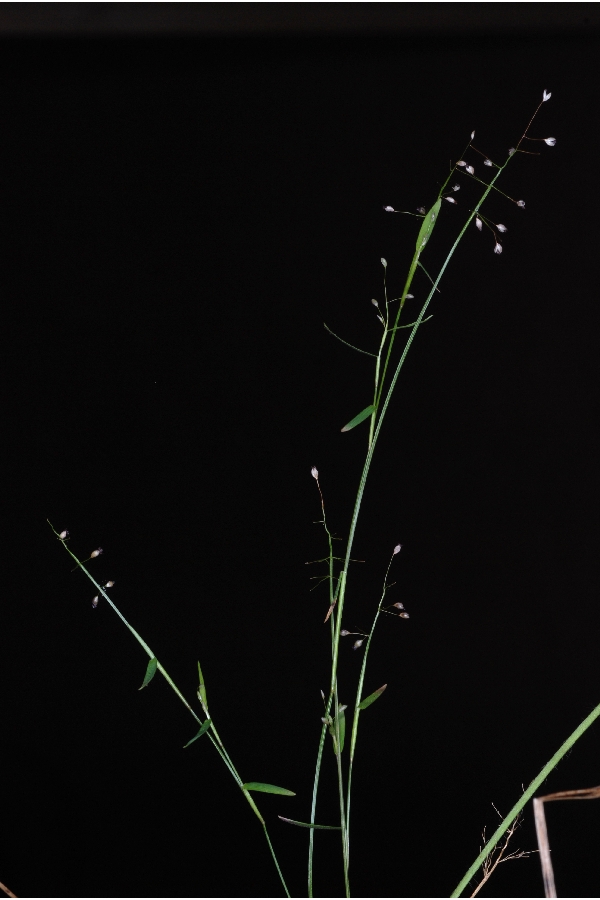Dichanthelium ensifolium
| Dichanthelium ensifolium | |
|---|---|

| |
| Photo by Doug Goldman, hosted by the USDA-NRCS PLANTS Database | |
| Scientific classification | |
| Kingdom: | Plantae |
| Division: | Magnoliophyta - Flowering plants |
| Class: | Liliopsida – Monocotyledons |
| Order: | Cyperales |
| Family: | Poaceae ⁄ Gramineae |
| Genus: | Dichanthelium |
| Species: | D. ensifolium |
| Binomial name | |
| Dichanthelium ensifolium (Baldw. ex Elliott) Gould & C.A. Clark | |

| |
| Natural range of Dichanthelium ensifolium from USDA NRCS Plants Database. | |
Common name: cypress panicgrass
Contents
Taxonomic notes
Description
Dichanthelium ensifolium is a perennial graminoid.
Generally, for the Dichanthelium genus, they have "spikelets usually in panicles, round or nearly so in cross section, 2-flowered, terminal fertile, basal sterile, neutral or staminate. First glume usually present, 2nd glume and sterile lemma similar; fertile lemma and palea indurate without hyaline margins. Taxonomically our most difficult and least understood genus of grasses, more than 100 species an varieties are ascribed to the Carolinas by some authors. Note general descriptions for species groups (e.g., 1-4, 5-8, 9-13, and 26-62)." - Radford et al 1964.
Specifically, for the D. ensifolium species, they are "very similar to D. tenue." They are a "perennial with distinct basal rosettes; branching, when present, from nodes above basal rosette. Leaves basal and cauline, vernal and autumnal. Very similar to D. tenue. Blade margins not strongly cartilaginous, bases frequently ciliate. Spikelets glabrous or puberulent, 1.3-1.6 mm long." - Radford et al 1964.
Distribution
Ecology
Habitat
D. ensifolium is found in moist to wet areas, in a variety of soils including peat, sand and silt over clay, loam, and loamy sand (FSU Herbarium). It is found in wet pine savannas[1], marshes, pine flatwoods, peat-sedge bogs, white cedar swamps, near streams, hillside seepage bogs, riparian mixed hardwood communities, mixed hardwood-bald cypress swamps, and sandhill scrub communities (FSU Herbarium). It also occurs in disturbed habitats including power line corridors, old fields, clear-cut and site prepared pine plantations, roadsides and near trails (FSU Herbarium).
Associated species include Sphagnum, D. nudicaule, Drosera, Rhynchospora (FSU Herbarium).
Phenology
Species has been observed flowering and fruiting in August, September, November, and December (FSU Herbarium).
Seed dispersal
Seed bank and germination
Fire ecology
D. ensifolium has been found in burned flatwoods and marshes (FSU Herbarium).
Average flowering stalk density increased significantly at sites in the first flowering season following fire[1].
Pollination
Use by animals
Diseases and parasites
Conservation and Management
Cultivation and restoration
Photo Gallery
References and notes
Florida State University Robert K. Godfrey Herbarium database. URL: http://herbarium.bio.fsu.edu. Last accessed: June 2014. Collectors: Loran C. Anderson, A.E. Radford, R. Kral, H. Kurz, Robert K. Godfrey, Angus Gholson, D. B. Ward, Grady W. Reinert, R. A. Norris, R. Komarek, Cecil R Slaughter, Marc Minno, Bob Fewster Ed Keppner, and Lisa Keppner. States and Counties: Alabama: Houston. Florida: Bay, Brevard, Flagler, Franklin, Gadsden, Hamilton, Holmes, Leon, Nassau, Orange, Osceola, Polk, Putnam, St. Johns, Suwannee, and Wakulla. Georgia: Echols, Grady, and Thomas. North Carolina: Lenoir, Pender, and Pitt.
Radford, Albert E., Harry E. Ahles, and C. Ritchie Bell. Manual of the Vascular Flora of the Carolinas. 1964, 1968. The University of North Carolina Press. 142-157. Print.